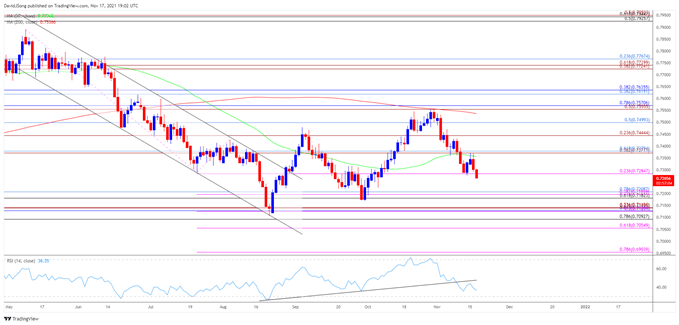Australian Dollar Talking Points
AUD/USD trades to a fresh monthly low (0.7262) as the Reserve Bank of Australia (RBA) retains a dovish forward guidance for monetary policy, and the exchange rate may continue to give back the advance from the October low (0.7192) as it fails to defend the opening range for November.
AUD/USD Eyes October Low Amid Failure to Defend Monthly Opening Range
AUD/USD remains under pressure following the failed attempt to trade above the 200-Day SMA (0.7537) as the update to Australia’s Employment report showed an unexpected decline in job growth, and the Australian Dollar may face headwinds throughout the remainder of the year as RBA anticipates “underlying inflation to pick up further, but to do so only gradually.”
In a recent speech, RBA Governor Philip Lowe insists that “the recovery is back on track following the interruption caused by the Delta outbreak,” but it seems as though the board will carry out an outcome-based approach as the central bank head pledges to use “wages growth as one of the guideposts in assessing progress towards our goal and whether inflation is sustainably in the target range.”
In turn, Governor Lowe reiterates that “our central scenario is that underlying inflation reaches the middle of the target by the end of 2023,” with the central bank head going onto say that “it is still plausible that the first increase in the cash rate will not be before 2024.”
As a result, the diverging paths between the RBA and the Federal Reserve may keep AUD/USD under pressure as Chairman Jerome Powell and Co. appear to be on track to implement higher interest rates in 2022, but a further decline in the exchange rate may fuel the recent flip in retail sentiment like the behavior seen earlier this year.
The IG Client Sentiment report shows 62.16% of traders are currently net-long AUD/USD, with the ratio of traders long to short standing at 1.64 to 1.
The number of traders net-long is 16.51% higher than yesterday and 25.59% higher from last week, while the number of traders net-short is 23.62% lower than yesterday and 15.38% lower from last week. The rise in net-long interest has fueled the crowding behavior as 53.35% of traders were net-long AUD/USD last week, while the decline in net-short position comes as the exchange rate trades to a fresh monthly low (0.7262).
With that said, the Australian Dollar may face headwinds throughout the remainder of the year as the RBA remains in no rush to implement higher interest rates, and the exchange rate may continue to give back the advance from the October low (0.7192)as it fails to defend the opening range for November.
AUD/USD Rate Daily Chart
Source: Trading View
- Keep in mind, AUD/USD traded to fresh yearly lows in the second-half of 2021 as the Relative Strength Index (RSI) slipped below 30 for the first time since March 2020, but lack of momentum to test the August low (0.7106) sparked a near-term correction in the exchange rate, with the pair approaching the 200-Day SMA (0.7548) in October as it cleared the September high (0.7478).
- However, the failed attempt to trade above the moving average has pushed AUD/USD back the 0.7370 (38.2% expansion) to 0.7380 (61.8% retracement) region, but need a close below the 0.7290 (23.6% expansion) area to bring the October low (0.7192) on the radar, which lines up with the Fibonacci overlap around 0.7180 (61.8% retracement) to 0.7210 (78.6% retracement).
- A break below the September low (0.7170) opening up the 0.7130 (61.8% retracement) to 0.7140 (23.6% expansion) region, with failure to defend the August low (0.7106) opening up the overlap around 0.7060 (61.8% expansion) to 0.7090 (78.6% retracement).
— Written by David Song, Currency Strategist
Follow me on Twitter at @DavidJSong



Be the first to comment